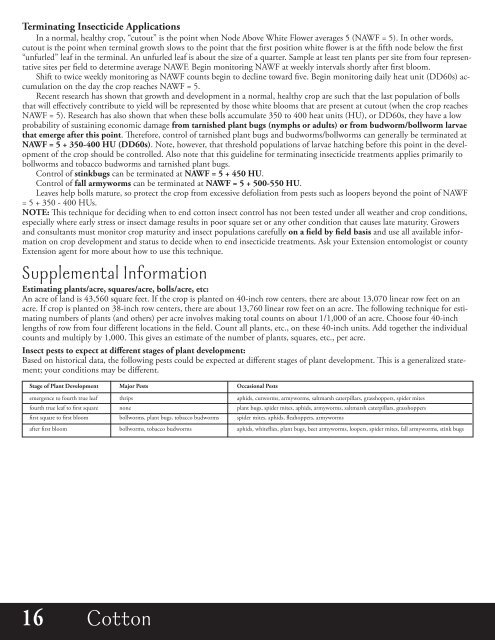Agronomic Crops
mJyPrJ
mJyPrJ
You also want an ePaper? Increase the reach of your titles
YUMPU automatically turns print PDFs into web optimized ePapers that Google loves.
terminating Insecticide Applications<br />
In a normal, healthy crop, “cutout” is the point when Node Above White Flower averages 5 (NAWF = 5). In other words,<br />
cutout is the point when terminal growth slows to the point that the first position white flower is at the fifth node below the first<br />
“unfurled” leaf in the terminal. An unfurled leaf is about the size of a quarter. Sample at least ten plants per site from four representative<br />
sites per field to determine average NAWF. Begin monitoring NAWF at weekly intervals shortly after first bloom.<br />
Shift to twice weekly monitoring as NAWF counts begin to decline toward five. Begin monitoring daily heat unit (DD60s) accumulation<br />
on the day the crop reaches NAWF = 5.<br />
Recent research has shown that growth and development in a normal, healthy crop are such that the last population of bolls<br />
that will effectively contribute to yield will be represented by those white blooms that are present at cutout (when the crop reaches<br />
NAWF = 5). Research has also shown that when these bolls accumulate 350 to 400 heat units (HU), or DD60s, they have a low<br />
probability of sustaining economic damage from tarnished plant bugs (nymphs or adults) or from budworm/bollworm larvae<br />
that emerge after this point. erefore, control of tarnished plant bugs and budworms/bollworms can generally be terminated at<br />
nAWF = 5 + 350-400 HU (DD60s). Note, however, that threshold populations of larvae hatching before this point in the development<br />
of the crop should be controlled. Also note that this guideline for terminating insecticide treatments applies primarily to<br />
bollworms and tobacco budworms and tarnished plant bugs.<br />
Control of stinkbugs can be terminated at nAWF = 5 + 450 HU.<br />
Control of fall armyworms can be terminated at nAWF = 5 + 500-550 HU.<br />
Leaves help bolls mature, so protect the crop from excessive defoliation from pests such as loopers beyond the point of NAWF<br />
= 5 + 350 - 400 HUs.<br />
note: is technique for deciding when to end cotton insect control has not been tested under all weather and crop conditions,<br />
especially where early stress or insect damage results in poor square set or any other condition that causes late maturity. Growers<br />
and consultants must monitor crop maturity and insect populations carefully on a field by field basis and use all available information<br />
on crop development and status to decide when to end insecticide treatments. Ask your Extension entomologist or county<br />
Extension agent for more about how to use this technique.<br />
Supplemental Information<br />
estimating plants/acre, squares/acre, bolls/acre, etc:<br />
An acre of land is 43,560 square feet. If the crop is planted on 40-inch row centers, there are about 13,070 linear row feet on an<br />
acre. If crop is planted on 38-inch row centers, there are about 13,760 linear row feet on an acre. e following technique for estimating<br />
numbers of plants (and others) per acre involves making total counts on about 1/1,000 of an acre. Choose four 40-inch<br />
lengths of row from four different locations in the field. Count all plants, etc., on these 40-inch units. Add together the individual<br />
counts and multiply by 1,000. is gives an estimate of the number of plants, squares, etc., per acre.<br />
Insect pests to expect at different stages of plant development:<br />
Based on historical data, the following pests could be expected at different stages of plant development. is is a generalized statement;<br />
your conditions may be different.<br />
stage of Plant Development Major Pests occasional Pests<br />
emergence to fourth true leaf thrips aphids, cutworms, armyworms, saltmarsh caterpillars, grasshoppers, spider mites<br />
fourth true leaf to first square none plant bugs, spider mites, aphids, armyworms, saltmarsh caterpillars, grasshoppers<br />
first square to first bloom bollworms, plant bugs, tobacco budworms spider mites, aphids, fleahoppers, armyworms<br />
after first bloom bollworms, tobacco budworms aphids, whiteflies, plant bugs, beet armyworms, loopers, spider mites, fall armyworms, stink bugs<br />
16 Crop Cotton Name


